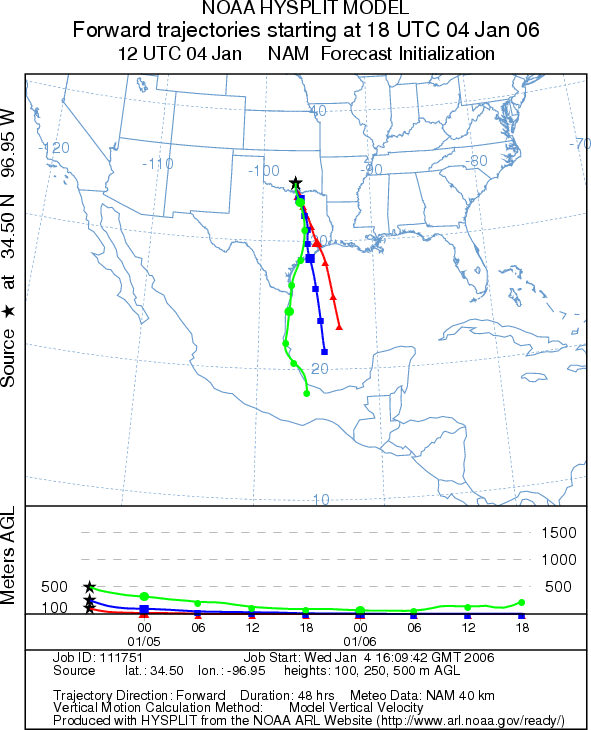The University of Tulsa
Mountain Cedar Pollen Forecast
Metropolitan Area |
Exposure Risk |
|
Oklahoma City |
Low |
|
Tulsa |
Low |
|
St. Louis MO |
Low |
Date Issued: 4 Jan 06
Mountain Cedar Location(s): Arbuckle Mountains, OK
Regional Weather: Wed.
and Thurs., Jan 04 and Jan 05. TX/OK: The
Texas/Oklahoma area will continue to warm and be dry today and tomorrow with high pressure building to the west.
There is no foreseeable chance of precipitation throughout the region, and the dip in temperatures yesterday are
expected to build back up today and tomorrow. Winds across the region will decrease a bit today but return to
gusty conditions tomorrow. A building high pressure zone over the central Rockies will cause wind directions to
switch to a southerly direction both today and tomorrow. High winds and continued low humidity, 10 to 20% in most
areas rising to about 40% in northern Oklahoma, will exacerbate the current efforts to control wild fires. A red
flag warning for fire danger is posted for an area from central Texas northward across eastern Oklahoma. To the
north, in Oklahoma, temperatures will be in the upper 50s to low 60s today. Overnight temperatures will remain
above freezing but in the thirties. Temperatures will remain in the same range tomorrow. In Texas highs today
will reach into the 60s to low 70s across the region. Nighttime temperatures will remain above freezing in the
low to mid 40s. Tomorrows highs will be about the same. Humidity will remain low during the day with values in
the 20 - 30% across the region.
Trajectory weather: The air mass trajectories move from
the Arbuckle Mountains to the south over eastern Texas towards the Gulf Coast. The trajectories are associated
with sinking atmospheric conditions that are characteristically poor for pollen entrainment and travel. However,
warm daytime temperatures, clear skies and low relative humidity are excellent conditions for pollen release.
OUTLOOK: *** Low threat *** Conditions are
very good for pollen release today, especially with the high shift in relative humidity between nighttime and low
daytime levels. However, the severe drought throughout the region may be preventing full maturation of the cones.
At this time increased levels of atmospheric pollen to the south along the eastern edge of the Edwards Plateau
indicates pollination is occurring throughout the region. Atmospheric conditions are poor for entrainment and
travel as they are characterized by sinking air. Pollen entrained and moving so close to the ground is more susceptible
to impaction on other vegetation resulting in low downwind concentrations. Therefore there is a low threat to
downwind communities. The southerly wind direction excludes any potential impact to Oklahoma City, Tulsa or beyond
the region.
Trajectory Start (s) (shown by black
star on map): Sulfur, OK.

Prepared by: Estelle
Levetin (Faculty of Biological
Science, The University
of Tulsa, 600 S. College, Tulsa, OK 74104) in conjunction with Peter K Van de Water. This forecast
gives the anticipated future track of released Mountain Cedar pollen, weather conditions over the region and along
the forecast pathway, and an estimated time of arrival for various metropolitan areas.
Questions: Aerobiology Lab e-mail: pollen@utulsa.edu
Return to Forecasting Home Page